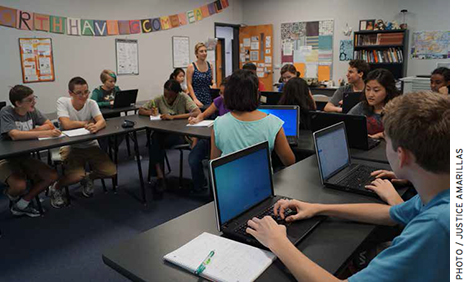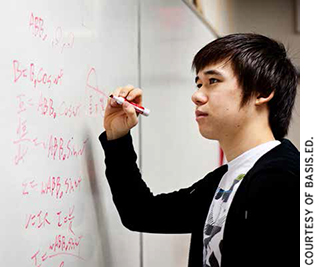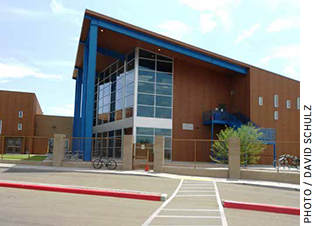While U.S. schools struggled to reach even an average score on a key international exam for 15-year-olds in 2012, BASIS Tucson North, an economically modest, ethnically diverse charter school in Arizona, outperformed every country in the world, and left even Shanghai, China’s academic gem in the dust.
How did that happen, I asked some of the school’s 9th graders, who variously sport braces and multiple ear studs; whose parents range from truck driver to epidemiologist; who talk of careers as a cardiovascular surgeon, a neurosurgeon, a hedge-fund manager.

“We do an incredible amount of work,” said Alia Gilbert.
“We push each other,” added Yasmeen Sharestha.
“We’re always thinking about college,” said Hannah Reilly. At that, the conversation moved on to the challenge of AP chemistry, what math to take after AP calculus, and a recent English class on the rhetoric of political campaigns.
Fifteen years after its founding by two economists—an American and a Czech, who fell in love at a seminar on the collapse of the Soviet Union—the BASIS network already roosts in the scholastic stratosphere. The Tucson charter school outscored all 40 countries that administered the 2012 PISA, or Programme for International Student Assessment exams, with a mean math score of 618, 131 points above the U.S. average. Its 10-year-old Scottsdale sister school scored even higher: 51 points above the metropolitan Shanghai area in math and 42 points higher in science.
The Washington Post and U.S. News & World Report, in their latest annual rankings, rate both schools among the five best in the country. BASIS students take an average 10 AP exams each, and in 2013 earned an average score on them of 3.9 out of 5. When I scanned the Tucson school’s bulletin board, I noticed that Princeton, Dartmouth, Brown, Harvard, and Williams all had accepted at least one of the 54 students in the 2013 graduating class, some of them on full scholarships; Stanford accepted four.
Teachers Are Scholars
For all that, BASIS schools are open admission. They operate on a shoestring budget: the Arizona schools operate on about two-thirds of the average funding for a child in a traditional public school. Classes are large: up to 30 students in middle school. Technology is “akin to cuneiform tablets,” Scottsdale’s head of school, Hadley Ruggles, told me.
The BASIS curriculum and its hard-charging teachers go a long way toward explaining the schools’ success. Fifth graders take Latin and can expect 90 minutes a day of homework. Middle schoolers have nine hours a week of biology, chemistry, and physics. Algebra starts in 6th grade; AP calculus is a graduation requirement. The English curriculum separates literature and language, or critical thought; high schoolers take both. There are year-end comprehensives; fail even one and it means repeating the grade.
When I visited the Tucson school, teacher Amanda Sweeney’s 9th-grade literature class was discussing Adventures of Huckleberry Finn. What is it about, Sweeney asked: race, slavery, freedom or, as Huck might say, “sivilization”? And why would he spell it that way?
“I want to put pressure on all your ideas,” Sweeney cajoled her students as they flipped through heavily underlined paperbacks, looking for “textual support” for their answers.
Teachers “have to be scholars” to teach at BASIS, Julia Toews, head of the Tucson school, told me when I asked what she looked for in her teachers. BASIS doesn’t require state teaching certification, but teachers must be “passionate” and “recognize the brilliance of kids,” she added.
Those kids are the other reason for the BASIS schools’ success. The rugged academics attract kids who told me they were bored at other schools and now revel in the challenge of vector calculus and molecular biology. At the Scottsdale campus, sophomore Charlie Murphy explained that he was “never challenged” until he arrived at BASIS in 5th grade. “I’m here for the academics,” he said.
BASIS teachers said that they offer slower learners abundant extra help, and that kids rise to meet the schools’ expectations. But at the same time, those expectations may scare off the less-able, less-interested students, which can mean a test-score bump for BASIS. Murphy told me that his class had 120 students when they arrived as 5th graders, but the group has dropped to 40, as youngsters have transferred to schools with bigger sports programs, more social offerings, or an easier course load. In Washington, D.C., where BASIS opened a school in 2012—its first outside Arizona—10 percent of the original 443 students had left by spring break, among them nearly one-third of those eligible for special education.
Recruiting is “hard,” says Michael Block, the affable 71-year-old who founded and heads the network with his wife, Olga. “This is not the normal school. No one has gone to a school like BASIS.”
With the U.S. frantic about its place in the global economy, employers desperate for skilled workers, and taxpayers and policymakers crying for more rigor from their schools, the question is “why?” Why isn’t this the normal school? Why shouldn’t it be?
Knowledge Revolution
As Michael Block tells it, he and Olga Block decided to apply for a school charter after she and her daughter moved to Arizona and were appalled by the weak curriculum in the public schools. Michael Block was a University of Arizona professor specializing in the economics of crime; Olga Block was an associate dean at Charles University in Prague. Michael calls the two of them “habitual educators.”
Olga Block tells the story somewhat differently. She’d watched as the Czechs shook off the economic lethargy of communism and embraced entrepreneurship within months of their Velvet Revolution. U.S. schools could do the same thing if they were freed of centralized control, she reasoned. “The need for knowledge is in everybody. You just need to wake it up.”
In 1998, the Blocks opened the first BASIS school (BASIS is an acronym whose underlying name has long since been abandoned) in a strip mall in Tucson. Michael Block said he concluded that “if you could do it there, you could do it everywhere.” One-quarter of Tucson families live below the poverty level, 42 percent are Hispanic, the median household income is $37,000. Yet in its eighth year, BASIS Tucson was ranked the sixth best high school in the U.S. by Newsweek magazine.
Five years after opening the Tucson school, the Blocks opened a Scottsdale charter school—this time in an empty medical center—because “everyone said you couldn’t compete with Scottsdale,” Michael Block said. Scottsdale is 9 percent Hispanic, the median household income is $72,000, the poverty rate is 7 percent. In 2012, 92 percent of the Scottsdale district’s 10th graders passed state year-end reading exams and 80 percent passed in math; all of BASIS Scottsdale’s 10th graders passed both.
BASIS has since opened seven other schools, and in 2012–13 enrolled 5,131 students in grades 5 through 12. In fall 2013, it plans to open a charter in San Antonio, Texas, plus three more Arizona schools, including a pilot K–4 in Tucson. Two private schools that follow the BASIS model are planned for Brooklyn, New York, and Sunnyvale, California, in 2014.
“It’s Cool to Be Smart”
That model starts with what BASIS calls a “bare bones” syllabus that’s common to all of the schools and is tested with a common comprehensive exam in the spring. Teachers add to that based on their specialties. Ruggles, the Scottsdale head, has a master’s degree in Slavic languages; the AP literature class she teaches is heavy on Dostoyevsky. In Tucson, Trudie Connolly, a 9th-grade language teacher, is redesigning her curriculum to reflect her interest in the intersection of literature and philosophy.
“We’re economists: we’re output focused, not input prescriptive,” Michael Block told me in explaining the independence BASIS gives its teachers.
About 60 percent of those teachers have master’s degrees; a few have PhDs. Many come from industry or academia. Connolly “flipped” houses. Petra Pajtas, the Romanian-born head of school in Phoenix, was a neuroscience researcher. Bill Weaver, the 5th-grade math teacher in Scottsdale, was a computer programmer.
When I sat in on Weaver’s class recently, his 5th graders were using a Saxon Math book for 7th and 8th graders, the standard BASIS 5th-grade text. Teachers said that such acceleration is central to moving kids through the network’s ambitious math and science programs.
A day earlier, at BASIS Phoenix, I’d sat in on a 6th-grade chemistry class that was practicing converting grams to molar mass with the question, “How many mole of Sn atoms are there in 0.0126 grams of Sn?” The answer, which requires a reference to the molar mass of tin on the periodic table, is 0.000106. The class tossed it off without difficulty.
“They rise to the occasion,” Weaver told me, offering three reasons why they can. “Parents are on top of the situation here. The culture here is you do your homework.” And when a lesson doesn’t click, “we just keep going over and over and over.”
I heard a lot about the BASIS culture: that “it’s cool to be smart,” that teachers “care,” that it’s “not an us vs. them culture.” “If there were popular kids, it would be the geeks,” Alia Gilbert, the Tucson 9th grader said.
At Scottsdale, teacher Marizza Bailey told me about the classes she was designing for 50 of her 11th and 12th graders who have maxed out the AP math curriculum. She’s planning classes in category theory, linear algebra, and vector calculus to accommodate them. “Whatever you want to do, they can teach you,” Charlie Murray said.
High schoolers can graduate after 11th grade—most of them have enough credits, and 10 to 20 percent do leave early—or they can devote 12th grade to individually designed post-post-AP classes and a senior project. In 2012, projects included the link between diabetes and depression, the effects of music therapy on autism, and the musculature of iguana limbs.
Can It Work Everywhere?

BASIS has run into trouble with that accelerated program in its D.C. school. Michael Block said the network opened a school in the nation’s capital to draw attention to its model: the more attention, the easier it will be to negotiate charters in other states, Olga Block figured. Months before its doors even opened, the school began offering remedial classes to incoming students, but math and reading skills are still weak.
“If they can’t read, what are we thinking about” teaching Latin, D.C. school head Paul Morrissey said to me. He also has abandoned physics for some 6th graders until they’ve mastered basic math skills. And about that BASIS culture of hard work and studiousness: “It’s been difficult to get buy-in,” he conceded.
Even so, 81 percent of BASIS DC students were proficient in reading and 77 percent were proficient in math on the D.C. standardized test results released in July 2013, less than a year after the school opened. That compares to a reading proficiency rate of 47 percent among traditional district school students and 53 percent among charter students generally, and math proficiency of 50 percent among traditional school kids and 59 percent among charter students.
BASIS says it has long waiting lists for its schools in Phoenix and Chandler, Arizona, where Intel Corporation has mammoth research and manufacturing facilities. But other schools are underenrolled, and the number of middle schoolers who don’t continue to high school is high. The entire network has only 226 youngsters in 11th and 12th grades, although Phoenix, D.C., and the other new schools don’t yet have upper grades. (Michael Block said 70 percent of middle schoolers now go on to BASIS high schools, up from 30 percent at the charters’ beginning.)
“You can’t make them be there; they have to want to go there,” says Mattida Raksanaves, whose children attend BASIS North. She has recruited 120 of the patients in her orthodontics practice to a second BASIS high school in Tucson. The schools have no playing fields—teams play in a charter-school league—and modest performing-arts spaces. On the day I visited Tucson North, the video board was promoting upcoming meetings of the chess club, science bowl, Model UN, and the cribbage club.
All that makes for a highly self-selected student body. The Tucson school, with 706 students, had just 30 on special education IEP and Section 504 plans in 2013. Systemwide, 11 percent of BASIS students are Hispanic and 28 percent are Asian, although Arizona is 30 percent Hispanic and 3 percent Asian. All but a handful of the network’s 300 African Americans are in D.C. And except in D.C., BASIS doesn’t take Title I or school-lunch funding, so it has no statistics on student poverty.
Targeting the Middle Class
The National Alliance for Public Charter Schools estimates there are 6,002 charter schools in the U.S., about 6 percent of all schools. But those charters remain largely an urban choice, serving mostly minority youngsters. More than half the youngsters in charters overall—but one-third of those in traditional schools—are black or Hispanic. The alliance says that one-half of the country’s charters are in cities, although just one-quarter of traditional public schools are.
Only one in five charters is in the suburbs, where most whites live. In D.C., my hometown, 43 percent of all students are in charters. But not a single charter is in the mostly white northwest neighborhoods, or across the district lines in those Maryland and Virginia suburbs where whites and Asian Americans are in the majority.

The reasons for that are both structural and cultural. It’s hard to find affordable facilities in the suburbs. Some state laws limit charters to big cities or so-called challenge districts. Sara Mead, a member of the District of Columbia Public Charter School Board and a principal at Bellwether Education Partners, adds that charters find it easier to fend off critics by operating in the inner cities rather than in the suburbs. Serving poor kids “has been a political defense of charters,” she said.
The biggest barrier to suburban charters may also be the most pregnable: parent satisfaction. Suburban and middle-class parents know how to engage with school authorities if they’re unhappy or can afford to move to another district. Although the most capable students may not be well served in all traditional districts, parents with means can often supplement with out-of-school programs or by taking advantage of dual enrollment options for high school students (see “High Schoolers in College,” features, Summer 2011). Districts can also offer selective-admission schools (see “Exam Schools from the Inside,” features, Fall 2012); a charter can bill itself as a school for the performing arts, for example, but it still must accept all comers and have a plan to support the youngster who is tone-deaf.
So far, high scores on relatively low-bar state tests have served to assure middle-class parents that their traditional public schools are good and their real-estate investments are safe. That could change when Common Core standards are introduced in 2014 and, with them, college-readiness exams that have been affirmed by each state’s universities, Andy Smarick, a Bellwether partner, told me. “The results will be jaw-dropping,” especially in districts that are used to acing state tests, he predicted. Many of those districts will respond by reinvesting in their schools with new curricula, more teachers, fancier technology. But some may turn to system-rattling reforms, like charters.
Charter Challenges
From its start, the BASIS target audience has been middle-class and working-class kids because “they have a stinky education, too,” Michael Block said. The network has few competitors in that demographic space (Great Hearts Academies, also in Arizona, is an exception), and Block said he has seen little interest from other education entrepreneurs.
One sure reason is funding. A 2010 Ball State University report titled “Charter School Funding: Inequity Persists” calculated that Arizona district schools received about $9,600 per student in 2006–07 compared to $7,600 per student in charters. In D.C., district schools received almost $30,000, compared to $17,500 for charters.
Michael Block said the BASIS schools received considerably less than that in 2013: $6,200 in Arizona and $12,000 in D.C., largely because they don’t qualify for most funds that target disadvantaged kids. Those funding disparities are behind the network’s plans to open what Block calls “moderately priced” private schools. So are the proscriptions in most states against hiring uncertified teachers, and, in some states, against exempting charter school teachers from local collective-bargaining agreements.
BASIS’s management structure, which includes a for-profit management company, excludes it from still other states. Each BASIS school is a nonprofit that owns its building; among other advantages, nonprofits more easily qualify for tax-free construction bonds. The for-profit, BASIS Schools, Inc., secures the charters, employs the teachers, and handles centralized functions. Among the advantages: it can opt out of Arizona’s teacher-retirement system and offer 401(k) plans instead.
Teacher pay starts at about $40,000 and tops off in the “mid-80s,” Michael Block said. There’s no tenure or uniform pay scale. Teachers receive bonuses based on the number of their students who pass AP exams—$200 for each student who passes with a score of 5; $100 for a 4—but schools must raise money themselves for other performance bonuses. An annual-fund auction at the Phoenix school in April offered a pet portrait by the photography teacher and a jewelry-making lesson with the biology teacher; a plate of pastries made by Petra Pajtas, school head, went for $125.
The Phoenix school building, like all other new BASIS schools, follows a template: it’s a strikingly modern steel and glass structure that was fabricated in Texas, trucked to Arizona, and assembled in four months at a cost of about $8 million, including the land. (Reed Construction Data, an information company, puts the cost of building a typical Phoenix school at $16.6 million. My local D.C. high school was recently rebuilt for $115 million.)
There’s no cafeteria or library. Floors are polished cement; the ductwork is exposed. Theater and orchestra audiences assemble on the parking lot; a garage door in front of them opens into the performing-arts room. I noticed overhead projectors and a cart of laptop computers, but there’s no technology lab. Fifth graders do their math on 8×10-inch white boards.
If proscenium stages and audiovisual equipment made a difference in student learning, the U.S. wouldn’t be struggling to keep up with the international average score on PISA, of course. That makes the BASIS model worth a long look.
“We want to get as good as the best in the world,” Michael Block told me. “Business holds itself to international standards. Why not schools?”
Yes, why not?
June Kronholz is a former Wall Street Journal foreign correspondent, bureau chief, and education reporter.
This article appeared in the Winter 2014 issue of Education Next. Suggested citation format:
Kronholz, J. (2014). High Scores at BASIS Charter Schools: Arizona students outperform Shanghai. Education Next, 14(1), 30-36.



